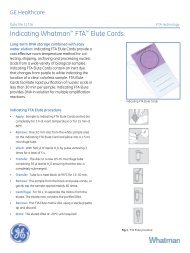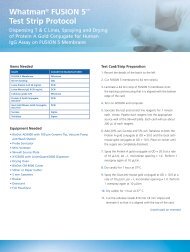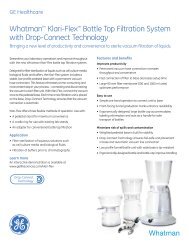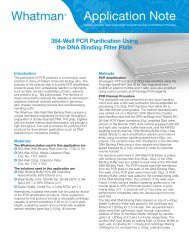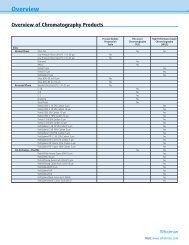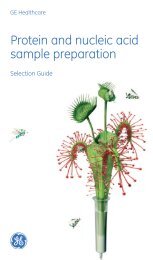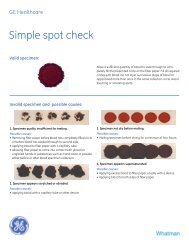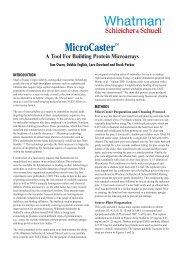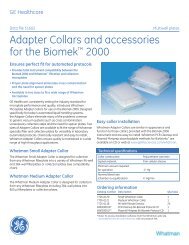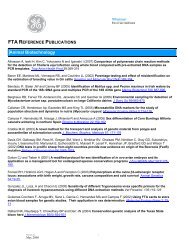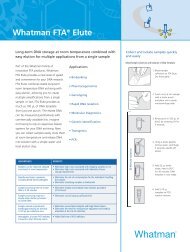Procedure for Whatman DMPK Cards
Procedure for Whatman DMPK Cards
Procedure for Whatman DMPK Cards
You also want an ePaper? Increase the reach of your titles
YUMPU automatically turns print PDFs into web optimized ePapers that Google loves.
May 19, 2009<br />
800 Centennial Avenue<br />
Piscataway, NJ 08855<br />
USA<br />
T 1 800 526 3593<br />
T 1 800 WHATMAN<br />
F 1 732 885 6529<br />
<strong>Procedure</strong> <strong>for</strong> <strong>Whatman</strong> <strong>DMPK</strong> <strong>Cards</strong><br />
Recommended guidelines <strong>for</strong> how to use <strong>Whatman</strong> <strong>DMPK</strong> <strong>Cards</strong>.<br />
1. Applying blood samples<br />
• Label the card.<br />
• Hold pipette tip or capillary a few mm above the card, not touching the card.<br />
• Expel the 15 µL sample smoothly and quickly (not spraying) as a drop that<br />
touches the card. The drop will quickly spread and soak in.<br />
• Dry the card thoroughly. Ship and store it desiccated at ambient temperatures.<br />
2. Analyzing samples<br />
• Cut a 3 mm disc from the sample area (avoiding the edge of the spot).<br />
• Transfer disc to labeled tube or multiwell plate.<br />
• Add 100 µL methanol (containing internal standard if desired) to elute<br />
analytes).<br />
• Vortex-mix gently 60 min and centrifuge briefly to remove any cellulose fibers.<br />
(See adjustments and additional in<strong>for</strong>mation below.)<br />
• Analyze supernatant by HPLC-MS/MS as usual.<br />
3. Possible adjustments <strong>for</strong> optimization<br />
• Test both <strong>DMPK</strong> card types initially, then focus on type giving better results <strong>for</strong><br />
the analytes of interest.<br />
• Adjust elution time – shorter <strong>for</strong> good analyte/solvent combinations or longer<br />
<strong>for</strong> weak ones. (See additional in<strong>for</strong>mation below.)<br />
• Larger blood volume, such as 40 µL, allows more discs per sample spot.<br />
• Select best elution solvent – HPLC mobile phase may be good.<br />
• Reduce elution volume, elute from 2 punches, or evaporate and re-dissolve<br />
extract in smaller volume <strong>for</strong> increased sensitivity.<br />
Please contact me with any additional questions.<br />
Regards,<br />
Jim Robbins<br />
James C. Robbins, Ph.D.<br />
Field Applications Scientist In Europe, please contact<br />
<strong>Whatman</strong>, Inc. Claire Dupont<br />
GE Healthcare Bio-Sciences Corp. <strong>DMPK</strong> Product Manager<br />
800 Centennial Ave - Bldg 1-244 Tel : +33 6 83 93 90 70<br />
Piscataway, NJ 08855 USA Claire.Dupont@ge.com<br />
<strong>Whatman</strong> Inc.
T +1 732 885 6519<br />
M +1 973 979 1372<br />
E Jim.Robbins@GE.com<br />
Additional In<strong>for</strong>mation<br />
<strong>Whatman</strong> Inc.<br />
• We strongly encourage new users to start with these recommended procedures<br />
and then to modify them if desired based on experience and goals.<br />
• The process is not difficult but some attention to the technique will maximize<br />
reproducibility of the results. The goal is to have the sample spread evenly on the<br />
card surface as it quickly soaks in, giving a spot area closely linked to the sample<br />
volume. The cards are designed and carefully manufactured <strong>for</strong> reproducible<br />
spread so it is only necessary to take advantage of that capability. The same<br />
technique can be used <strong>for</strong> serum or plasma. If the samples are colorless it may<br />
be useful to mark the sample area with a pencil or pen be<strong>for</strong>e it dries.<br />
• Normally the blood samples contain an anticoagulant such as EDTA or the<br />
sample capillary is coated with it. The cards contain components that rapidly lyse<br />
cells, inactivate pathogens and denature proteins. They do not require<br />
anticoagulants, as long as the blood has not already begun to clot, but are<br />
compatible with them.<br />
• The pipette or capillary tip should be held a little above the card, not touching it.<br />
Sample is then expelled smoothly and quickly, without spraying, into a drop that<br />
touches the card. This way the sample spreads quickly and evenly on the card as<br />
it soaks in. If the pipette or capillary tip were held in contact with the card during<br />
dispensing, the liquid flow would tend to be more through the card, encouraging<br />
local depletion of the card’s chemical components. The flow would probably be<br />
more directional, resulting in uneven sample distribution. These results would be<br />
more likely to vary between samples and between operators.<br />
• Carryover of analytes from punch to punch has not been a practical problem as<br />
long as the cards were thoroughly dry, preventing carryover of fibers. You can<br />
also clean the punching tool by cutting a waste disc between samples from an<br />
unused part of the card.<br />
• Results to date have shown little variation with where in the spot the discs are<br />
taken. We do not recommend sampling from the very edge of the blood spot. In<br />
some cases, particularly with the FTA Elute <strong>for</strong>mulation, a pink halo surrounds the<br />
blood spot. We recommend sampling from the dark, inner main spot.<br />
• Elution of analytes with organic solvents will leave protein precipitated in the<br />
cards. Some of the cards’ chemical components will be eluted with the analytes.<br />
Thus far these have not seriously interfered in analyte quantitation by HPLC-<br />
MS/MS.<br />
• Elution with a good solvent should be much faster than 60 min but time<br />
minimization experiments have not been done yet.





